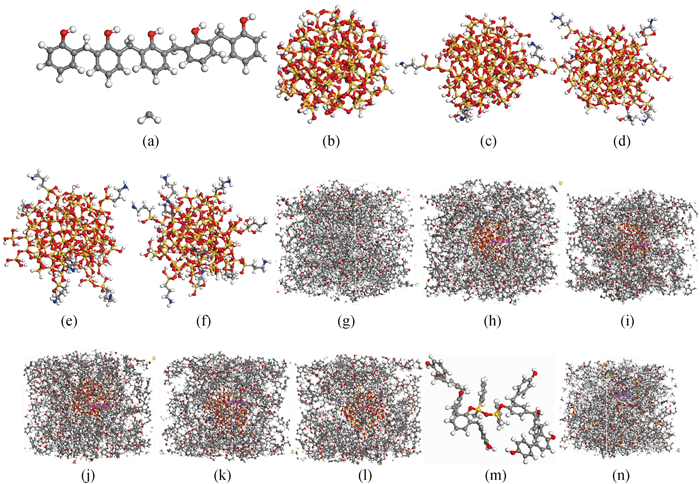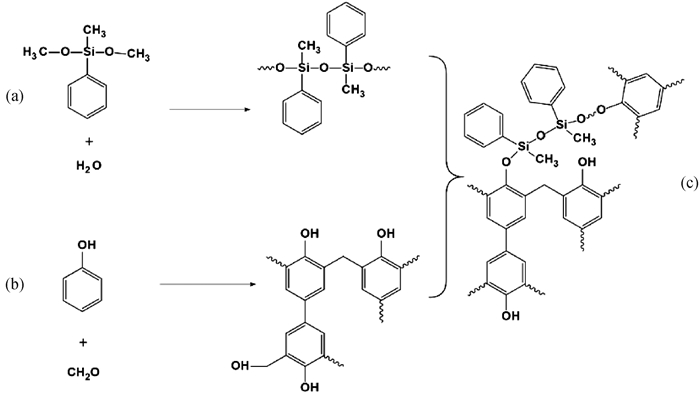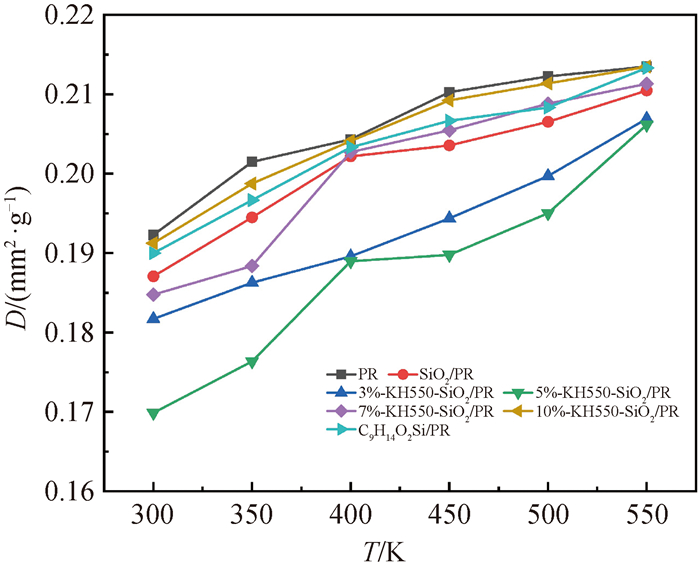Chinese Journal of Computational Physics ›› 2024, Vol. 41 ›› Issue (3): 345-356.DOI: 10.19596/j.cnki.1001-246x.8710
Previous Articles Next Articles
Bili XU1( ), Zhao JING2, Xiao LIU3, Bo DAI1, Guangfu JI4, Kuibao ZHANG1, Nina GE1,*(
), Zhao JING2, Xiao LIU3, Bo DAI1, Guangfu JI4, Kuibao ZHANG1, Nina GE1,*( )
)
Received:2023-02-17
Online:2024-05-25
Published:2024-05-25
Contact:
Nina GE
CLC Number:
Bili XU, Zhao JING, Xiao LIU, Bo DAI, Guangfu JI, Kuibao ZHANG, Nina GE. Molecular Dynamics Simulation of Physical Properties of Silicon Modified Phenolic Resin[J]. Chinese Journal of Computational Physics, 2024, 41(3): 345-356.
Add to citation manager EndNote|Ris|BibTeX
URL: http://www.cjcp.org.cn/EN/10.19596/j.cnki.1001-246x.8710

Fig.1 (a) PR and methylene monomer; (b) SiO2 monomer; (c) 3% KH550-SiO2 monomer; (d) 5% KH550-SiO2 monomer; (e) 7% KH550-SiO2 monomer; (f) 10% KH550-SiO2 monomer; (g) unmodified-PR cross-linking system; (h) nano-SiO2/PR cross-linking system; (i) 3% KH550-SiO2/PR cross-linking system; (j) 5%KH550-SiO2/PR cross-linking system; (k) 7%KH550-SiO2/PR cross-linking system; (l) 10%KH550-SiO2/PR cross-linking system; (m) C9H14O2Si/PR monomer; (n) C9H14O2Si/PR cross-linking system

Fig.3 Schematic diagram of phenolic resin modified by methylphenyldimethoxysilane (a) silane hydrolysis polymerization; (b) polymerization of phenol and formaldehyde to form novolac resins; (c) synthesis of silicon phenolic resin from polysilane and novolak resin
| 密度/(g·m-3) | 体积/Å3 | 能量/(kcal·mol-1) | |
| 交联前 | 0.88 | 84 284.5 | 6 264.41 |
| 交联后 | 1.06 | 69 434.7 | -2 258.54 |
Table 1 System parameters before and after crosslinking
| 密度/(g·m-3) | 体积/Å3 | 能量/(kcal·mol-1) | |
| 交联前 | 0.88 | 84 284.5 | 6 264.41 |
| 交联后 | 1.06 | 69 434.7 | -2 258.54 |

Fig.6 Variation of specifice volume with temperature (a) Unmodified-PR (b) SiO2/PR; (c) 3%KH550-SiO2 /PR; (d) 5%KH550-SiO2 /PR; (e) 7%KH550-SiO2/PR; (f) 10%KH550-SiO2/PR; (g) C9H14O2Si/PR
| 模型 | Tg/K | α/(10-6 K-1) | |
| T<Tg | T>Tg | ||
| PR | 362 | 38 | 84 |
| SiO2/PR | 369 | 26 | 72 |
| 3%KH550-SiO2/PR | 400 | 20.8 | 50.6 |
| 5%KH550-SiO2/PR | 415 | 22 | 64 |
| 7%KH550-SiO2/PR | 423 | 8 | 42.9 |
| 10%KH550-SiO2/PR | 429.6 | 30 | 66 |
| C9H14O2Si/PR | 367.5 | 44 | 97.1 |
Table 2 Tg and α of 7 models
| 模型 | Tg/K | α/(10-6 K-1) | |
| T<Tg | T>Tg | ||
| PR | 362 | 38 | 84 |
| SiO2/PR | 369 | 26 | 72 |
| 3%KH550-SiO2/PR | 400 | 20.8 | 50.6 |
| 5%KH550-SiO2/PR | 415 | 22 | 64 |
| 7%KH550-SiO2/PR | 423 | 8 | 42.9 |
| 10%KH550-SiO2/PR | 429.6 | 30 | 66 |
| C9H14O2Si/PR | 367.5 | 44 | 97.1 |

Fig.11 MSD over time with different modules and temperature (a) unmodified-PR; (b) SiO2/PR; (c) 3%KH550-SiO2/PR; (d) 5%KH550-SiO2/PR; (e) 7%KH550-SiO2/PR; (f) 10%KH550-SiO2/PR; (g) C9H14O2Si/PR
| 1 |
TANG Kaihong , ZHANG Ailing , GE Tiejun , et al. Research progress on modification of phenolic resin[J]. Materials Today Communications, 2021, 26, 101879.
DOI |
| 2 | 赵振宁, 王辉, 虎琳. 航空航天先进复合材料研究现状及发展趋势[J]. 炭素, 2021, (2): 24- 29. |
| 3 | 邢亚娟, 孙波, 高坤, 等. 航天飞行器热防护系统及防热材料研究现状[J]. 宇航材料工艺, 2018, 48 (4): 9- 15. |
| 4 |
陈智琴, 李文魁, 曾卫军, 等. 耐烧蚀酚醛树脂的研究进展[J]. 工程塑料应用, 2007, 35 (11): 70- 73.
DOI |
| 5 | 许国娟, 陈敬菊, 潘天池, 等. 酚醛树脂耐热改性的研究进展[J]. 复合材料科学与工程, 2021, (8): 120- 128. |
| 6 |
江立鼎, 张健, 刘智伟. 酚醛树脂耐热改性研究进展[J]. 山东化工, 2021, 50 (5): 100- 101.
DOI |
| 7 | 向靖宇, 刘春霞, 马凤国. 高性能有机硅改性酚醛树脂的研究进展[J]. 有机硅材料, 2019, 33 (1): 71- 74. |
| 8 |
孙保帅, 彭进, 邹文俊. 纳米SiO2改性酚醛树脂结合剂耐热性能的研究[J]. 化学工程师, 2009, 23 (9): 4- 6.
DOI |
| 9 |
ASARO L , MANFREDI L B , PELLICE S , et al. Innovative ablative fire resistant composites based on phenolic resins modified with mesoporous silica particles[J]. Polymer Degradation and Stability, 2017, 144, 7- 16.
DOI |
| 10 |
DING Jie , QIN Zhiying , LUO Haitao , et al. Nano-silica modified phenolic resin film: Manufacturing and properties[J]. Nanotechnology Reviews, 2020, 9 (1): 209- 218.
DOI |
| 11 | 薛茹君. 无机纳米材料的表面修饰改性与物性研究[D]. 合肥: 合肥工业大学, 2008. |
| 12 |
游胜勇, 戴润英, 董晓娜, 等. 硅烷偶联剂改性酚醛树脂的合成[J]. 合成树脂及塑料, 2017, 34 (6): 17- 19.
DOI |
| 13 |
DUAN Liuyang , ZHAO Xing , WANG Yiguang . Oxidation and ablation behaviors of carbon fiber/phenolic resin composites modified with borosilicate glass and polycarbosilane interface[J]. Journal of Alloys and Compounds, 2020, 827, 154277.
DOI |
| 14 |
LI Shan , HAN Yue , CHEN Fenghua , et al. The effect of structure on thermal stability and anti-oxidation mechanism of silicone modified phenolic resin[J]. Polymer Degradation and Stability, 2016, 124, 68- 76.
DOI |
| 15 |
ZHANG Guangwu , SHI Minxian , HUANG Chi , et al. Synthesis and properties of polyphenylsilsesquioxane modified phenolic resin by in-situ polymerization from phenyltriethoxysilane precursor[J]. Journal of Macromolecular Science, Part B, 2016, 55 (8): 810- 821.
DOI |
| 16 |
SHUDO Y , IZUMI A , HAGITA K , et al. Structure-mechanical property relationships in crosslinked phenolic resin investigated by molecular dynamics simulation[J]. Polymer, 2017, 116, 506- 514.
DOI |
| 17 |
SHUDO Y , IZUMI A , HAGITA K , et al. Large-scale molecular dynamics simulation of crosslinked phenolic resins using pseudo-reaction model[J]. Polymer, 2016, 103, 261- 276.
DOI |
| 18 |
MONK J D , HASKINS J B , BAUSCHLICHER C W Jr , et al. Molecular dynamics simulations of phenolic resin: Construction of atomistic models[J]. Polymer, 2015, 62, 39- 49.
DOI |
| 19 |
王中. SiO2纳米粒子改性对酚醛树脂材料性能的影响[J]. 计算机与应用化学, 2013, 30 (12): 1465- 1470.
DOI |
| 20 | 林杰. 基于Materials Studio的聚合物基纳米复合材料力学性能模拟[D]. 广州: 暨南大学, 2013. |
| 21 | 张惠. 改性纳米粒子增强聚合物基复合材料力学性能的分子动力学模拟研究[D]. 广州: 暨南大学, 2014. |
| 22 | 杜灵根, 焦丕玉, 王晓梅. 环氧树脂结构建模及玻璃化转变温度模拟计算[J]. 绝缘材料, 2012, 45 (2): 44- 47. |
| 23 |
曹炳阳. 一种模拟热导率的非平衡分子动力学方法[J]. 计算物理, 2007, 24 (4): 463- 466.
DOI |
| 24 |
MVLLER-PLATHE F . A simple nonequilibrium molecular dynamics method for calculating the thermal conductivity[J]. The Journal of Chemical Physics, 1997, 106 (14): 6082- 6085.
DOI |
| 25 |
JUND P , JULLIEN R . Molecular-dynamics calculation of the thermal conductivity of vitreous silica[J]. Physical Review B, 1999, 59 (21): 13707- 13711.
DOI |
| 26 |
刘其鑫, 姜培学, 向恒. 纳米多孔氩薄膜热导率的分子动力学模拟[J]. 计算物理, 2008, 25 (4): 457- 462.
DOI |
| 27 |
LUSSETTI E , TERAO T , MVLLER-PLATHE F . Nonequilibrium molecular dynamics calculation of the thermal conductivity of amorphous polyamide-6, 6[J]. Journal of Physical Chemistry B, 2007, 111 (39): 11516- 11523.
DOI |
| 28 |
MATSUBARA H , KIKUGAWA G , BESSHO T , et al. Non-equilibrium molecular dynamics simulation as a method of calculating thermodynamic coefficients[J]. Fluid Phase Equilibria, 2016, 421, 1- 8.
DOI |
| 29 |
NIETO-DRAGHI C , AVALOS J B . Non-equilibrium momentum exchange algorithm for molecular dynamics simulation of heat flow in multicomponent systems[J]. Molecular Physics, 2003, 101 (14): 2303- 2307.
DOI |
| 30 |
ZHANG Xiaoxing , WEN Hao , WU Yunjian , et al. Computational thermomechanical properties of silica-epoxy nanocomposites by molecular dynamic simulation[J]. Polymers, 2017, 9 (9): 430.
DOI |
| 31 |
WANG Liang , LIU Mengxin , YANG Feihao , et al. Comparative study on the structure, mechanical, thermal, and tribological properties of PF composites reinforced by different kinds of mesoporous silicas[J]. Journal of Inorganic and Organometallic Polymers and Materials, 2021, 31 (7): 2939- 2948.
DOI |
| 32 | BIAN Cheng , WANG Shujuan , LIU Yuhong , et al. Role of nonbond interactions in the glass transition of novolac-type phenolic resin: A molecular dynamics study[J]. Industrial & Engineering Chemistry Research, 2016, 55 (35): 9440- 9451. |
| 33 |
MONK J D , BUCHOLZ E W , BOGHOZIAN T , et al. Computational and experimental study of phenolic resins: Thermal-mechanical properties and the role of hydrogen bonding[J]. Macromolecules, 2015, 48 (20): 7670- 7680.
DOI |
| 34 |
JITHIN A J A , PANIGRAHI S K , SASIKUMAR P , et al. Ablative properties, thermal stability, and compressive behaviour of hybrid silica phenolic ablative composites[J]. Polymer Degradation and Stability, 2022, 203, 110063.
DOI |
| 35 |
YEH M K , TAI N H , LIN Y J . Mechanical properties of phenolic-based nanocomposites reinforced by multi-walled carbon nanotubes and carbon fibers[J]. Composites Part A: Applied Science and Manufacturing, 2008, 39 (4): 677- 684.
DOI |
| 36 | TAHERI-BEHROOZ F , MEMAR MAHER B , SHOKRIEH M M . Mechanical properties modification of a thin film phenolic resin filled with nano silica particles[J]. Computational Materials Science, 2015, 96 (Part B): 411- 415. |
| 37 | 孙伟松, 于思荣, 陈生辉, 等. 高交联度DGEBA/3, 3'-DDS环氧树脂涂层热力学性能的分子动力学模拟[J]. 当代化工, 2022, 51 (10): 2445-2449, 2454. |
| 38 |
ZHENG Wei , TANG Chao , XIE Jufang , et al. Micro-scale effects of nano-SiO2 modification with silane coupling agents on the cellulose/nano-SiO2 interface[J]. Nanotechnology, 2019, 30 (44): 445701.
DOI |
| 39 | 王雪梅, 董斌, 朱子亮, 等. 聚合物分子与官能化纳米管相互作用及扩散特性的分子动力学模拟[J]. 计算物理, 2020, 37 (5): 589- 594. |
| [1] | Yu LI, Huiqing LIU, Yabin FENG, Xiaohu DONG, Qing WANG, Bo ZHANG. Adsorption Behavior of Heavy Oil on Montmorillonite Surface by Typical Surfactant: Molecular Dynamics Simulation [J]. Chinese Journal of Computational Physics, 2023, 40(5): 583-596. |
| [2] | Zhaozhao WEI, Kai LIU, Huijun LI. Molecular Dynamics Simulation of Deformation Behavior of NiAl Nanowire Under Bending [J]. Chinese Journal of Computational Physics, 2023, 40(4): 425-435. |
| [3] | Zhaoyang HOU, Yuan NIU, Qixin XIAO, Zhen WANG, Qingtian DENG. Simulation of Mechanical Behavior and Deformation Mechanism of Al Nanowires Along Different Crystal Orientations [J]. Chinese Journal of Computational Physics, 2022, 39(3): 341-351. |
| [4] | Hubao A, Zhibing YANG, Ran HU, Yifeng CHEN. Molecular Dynamics Simulations of Capillary Dynamics at the Nanoscale [J]. Chinese Journal of Computational Physics, 2021, 38(5): 603-611. |
| [5] | WANG Guohua, CUI Yaru, YANG Ze, LI Xiaoming, TANG Hongliang, YANG Shufeng. Potential Function and Molecular Dynamics Simulation for FexO-SiO2-CaO-MgO-“NiO” Nickel Slag [J]. Chinese Journal of Computational Physics, 2021, 38(2): 215-223. |
| [6] | ZHOU Lu, MA Honghe. Numerical Simulation of Heat Transfer of Synthetic Oil-based Nanofluids in a Parabolic Trough Solar Receiver [J]. CHINESE JOURNAL OF COMPUTATIONAL PHYSICS, 2021, 38(1): 99-105. |
| [7] | WANG Xuemei, DONG Bin, ZHU Ziliang, YANG Junsheng. Interfacial Interaction and Diffusion Properties of Functionalized CNT/Polymer Systems: Molecular Dynamics Simulations [J]. CHINESE JOURNAL OF COMPUTATIONAL PHYSICS, 2020, 37(5): 589-594. |
| [8] | HE Erbin, LUO Zhirong, ZHU Liuhua. Atomistic Analysis of Myoglobin Mechanical Unfolding [J]. CHINESE JOURNAL OF COMPUTATIONAL PHYSICS, 2020, 37(2): 205-211. |
| [9] | ZHOU Lu, MA Honghe. Molecular Dynamics Simulation on Crystallization Kinetics of Sodium Sulfate in Supercritical Water [J]. CHINESE JOURNAL OF COMPUTATIONAL PHYSICS, 2020, 37(2): 212-220. |
| [10] | CHAI Rukuan, LIU Yuetian, WANG Junqiang, XIN Jing, PI Jian, LI Changyong. Molecular Dynamics Simulation of Wettability of Calcite and Dolomite [J]. CHINESE JOURNAL OF COMPUTATIONAL PHYSICS, 2019, 36(4): 474-482. |
| [11] | WANG Shuaichuang, ZHANG Gongmu, SUN Bo, SONG Haifeng, TIAN Mingfeng, FANG Jun, LIU Haifeng. Quantum Molecular Dynamics Simulations of Transport Properties of Liquid Plutonium [J]. CHINESE JOURNAL OF COMPUTATIONAL PHYSICS, 2019, 36(3): 253-258. |
| [12] | LIANG Hua, LI Maosheng. Molecular Dynamics Study of Mechanical Properties of Single Crystal Aluminum with Voids and Vacancies [J]. CHINESE JOURNAL OF COMPUTATIONAL PHYSICS, 2019, 36(2): 211-218. |
| [13] | ZHANG Haiyan, YIN Xinchun. Molecular Dynamics Study on Growth Mechanism of Pure Metals Solid-Liquid Interface During Solidification [J]. CHINESE JOURNAL OF COMPUTATIONAL PHYSICS, 2019, 36(1): 80-88. |
| [14] | TAN Junhua, PENG Junhui. First-Principles Study on Structure and Properties of Graphite Intercalation Compound HfC2 [J]. CHINESE JOURNAL OF COMPUTATIONAL PHYSICS, 2018, 35(5): 613-618. |
| [15] | ZHOU Huanlin, YAN Jun, YU Bo, CHEN Haolong. Identification of Thermal Conductivity for Transient Heat Conduction Problems by Improved Cuckoo Search Algorithm [J]. CHINESE JOURNAL OF COMPUTATIONAL PHYSICS, 2018, 35(2): 212-220. |
| Viewed | ||||||
|
Full text |
|
|||||
|
Abstract |
|
|||||
Copyright © Chinese Journal of Computational Physics
E-mail: jswl@iapcm.ac.cn
Supported by Beijing Magtech Co., Ltd.
